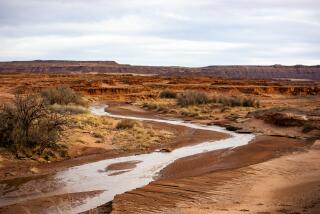Other Factors in Navajo-Hopi Dispute
- Share via
I take exception to a couple of statements (Letters, Sept. 6) by Ross Swimmer, assistant secretary of the Interior for Indian Affairs regarding the Hopi-Navajo dispute.
Swimmer says that the Navajos on Hopi land “are being offered the opportunity, however, to accept new housing, grazing lands and other benefits on the Navajo reservation.” Not surprisingly, he neglects to mention that a major place on the Navajo reservation where the feds want to move these people is the Chamber-Saunders area.
This area is along the Rio Puerco, downstream from the largest nuclear spill ever, where a massive uranium-tailings dam collapsed and spilled radioactive water into the Rio Puerco on July 16, 1979.
Not only are “new housing, grazing lands and other benefits” not being offered at Big Mountain, but Navajos cannot build a structure (or even improve their homes) under the 1974 Public Law 93-531. The Bureau of Indian Affairs has not only reduced Navajo herds by 90%, but continues to kill and confiscate their sheep.
Increasingly, precious water is being diverted from people and herds, fencing continues, crops are being plowed under, and low-flying aircraft scare occupants off their sacred land.
Swimmer continues, “These benefits cannot be made available at their present location because of poor quality land and the ongoing ownership dispute.” Swimmer is well aware that Peabody Coal (with the cooperation of the Hopi Tribal Council) is anxious to strip mine about 21 billion tons of coal from beneath the “poor quality” Big Mountain area, plus he realizes that there is plenty of uranium there to fire another generation of nuclear reactors and weapons.
BRUCE CAMPBELL
Los Angeles
More to Read
Sign up for Essential California
The most important California stories and recommendations in your inbox every morning.
You may occasionally receive promotional content from the Los Angeles Times.











